name: mila-ethics-sustainability-may25 class: title, middle ## Connecting the Dots between AI Ethics and Sustainability Alex Hernández-García (he/il/él) .turquoise[Mila's Responsible AI & Human Rights Summer School · Tiohtià:ke / Montréal · May 30th 2025] .center[ <a href="https://mila.quebec/"><img src="../assets/images/slides/logos/mila-white-v2.png" alt="Mila" style="width: 12em"></a> <a href="https://www.umontreal.ca/"><img src="../assets/images/slides/logos/udem-white.png" alt="UdeM" style="width: 12em"></a> ] .center[ <a href="https://institut-courtois.umontreal.ca/"><img src="../assets/images/slides/logos/institut-courtois.png" alt="Institut Courtois" style="height: 2.5em"></a> <a href="https://ivado.ca/"><img src="../assets/images/slides/logos/ivado.png" alt="IVADO" style="height: 2.5em"></a> ] .smaller[.footer[ Slides: [alexhernandezgarcia.github.io/slides/{{ name }}](https://alexhernandezgarcia.github.io/slides/{{ name }}) ]] .qrcode[] --- .left-column[ <figure> <img src="../assets/images/slides/ai-env-impact/news_le-devoir.png" alt="Les émissions de carbone de Google ont augmenté de 48% en cinq ans à cause de l’IA" style="width: 110%"> <figcaption>.center[.smaller[<a href="https://www.ledevoir.com/environnement/815840/emissions-carbone-google-ont-augmente-48-cinq-ans-cause-ia">Le Devoir</a>, July 2nd 2024]]</figcaption> </figure> <figure> <img src="../assets/images/slides/ai-env-impact/news_radio-canada.png" alt="L’IA aide à protéger l’environnement… mais à quel coût environnemental?" style="width: 110%"> <figcaption>.center[.smaller[<a href="https://ici.radio-canada.ca/nouvelle/2045059/changements-climatiques-intelligence-artificielle-environnement-ia">Radio Canada</a>, January 27th 2024]]</figcaption> </figure> <figure> <img src="../assets/images/slides/ai-env-impact/news_la-presse.png" alt="Un impact environnemental monstre" style="width: 110%"> <figcaption>.center[.smaller[<a href="https://www.lapresse.ca/affaires/economie/2023-06-03/intelligence-artificielle/un-impact-environnemental-monstre.php">La Presse</a>, June 3rd 2023]]</figcaption> </figure> ] .right-column[ <br><br><br> <figure> <img src="../assets/images/slides/ai-env-impact/news_science-presse.png" alt="L’empreinte environnementale sous-estimée de l’IA" style="width: 110%"> <figcaption>.center[.smaller[<a href="https://www.sciencepresse.qc.ca/actualite/2024/02/26/empreinte-environnementale-estimee-ia">Science Presse</a>, February 26th 2024]]</figcaption> </figure> <figure> <img src="../assets/images/slides/ai-env-impact/news_hec.png" alt="L’Impact Écologique de l’Intelligence Artificielle : Un Défi à l’Ère du Numérique" style="width: 110%"> <figcaption>.center[.smaller[<a href="https://www.lapresse.ca/affaires/economie/2023-06-03/intelligence-artificielle/un-impact-environnemental-monstre.php">Digital HEC</a>, March 27th 2024]]</figcaption> </figure> ] --- count: false name: title class: title, middle ## The carbon emissions of AI .center[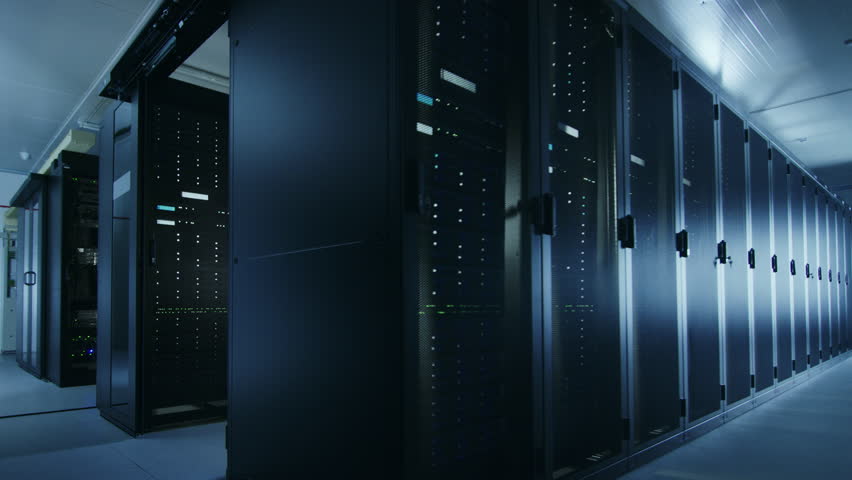] --- ## Why does AI consume so much energy ? -- .highlight1[Short and simple answer]: Artificial intelligence models are run in computers and computers consume energy. -- > _But a computer doesn't require so much energy, does it?_ -- > _Not really... But it depends!_ -- > _So?_ -- This question and its answers are unfortunately more complex than it seems on the surface. Let's consider these other questions: - Why does transportation consume so much energy? - Why does food production consume so much energy? ??? Walking and biking is not energy-demanding, but transportation within car culture and mindless flying is. Traditional agriculture is not energy-demanding, but food production based on animal products and fertilizers is. -- .conclusion[Artificial intelligence is not necessarily energy-intensive. Small-scale, effective AI is in theory possible. The main problem is the scale we have reached.] --- ## Why does AI consume so much energy ? ### A more subtle answer -- .left-column[ What is an artificial intelligence model? We can see the backbone of AI models as computer programs that transform input data through mathematical operations to produce output data. ] .right-column[ .center[ <figure> <img src="../assets/images/slides/ai-env-impact/schematic_neural_network.png" alt="Schematic of a neural network" style="width: 100%"> .smaller[<figcaption>Schematic of a very simple neural network.</figcaption>] </figure> ] ] -- .right-column[ .conclusion[Each mathematical operation consumes a bit of energy. Large AI models perform a myriad of these operations.] ] --- ## Why does AI consume so much energy ? ### A more subtle answer -- It is important to distinguish the two main phases in the life of an artificial intelligence model: .highlight1[training] and .highlight1[deployment] -- - .highlight1[Training]: This is the process of adjusting the weights that determine the mathematical operations in the neural network so that the model successfully performs the desired task. Some models can be trained on a laptop in minutes or hours. The models behind systems like ChatGPT require several weeks and many powerful computers. -- - .highlight1[Deployment]: This is the use phase of the model once it has been trained. Some models are only moderately used. Systems like ChatGPT are currently used every minute by millions of users. -- .conclusion[It is this large-scale deployment of huge models what poses the main problem in a context of climate crisis.] ??? Talk about scaling is all you need and this philosophy promoted from the industry as part of a capitalist mindset. --- ## Estimation of the carbon of emissions of artificial intelligence What are the factors influencing the greenhouse gas emissions of AI models? 1. .highlight1[Training time], $T$: total time using computational resources (hours). 2. .highlight1[Electric power], $P$: of the compute hardware (watts). 3. .highlight1[Carbon intensity], $I$: the amount of greenhouse gas emissions per unit of energy produced by the energy source. (grams of CO2 equivalent per kilowatt-hour). .references[ Luccioni and Hernandez-Garcia. [Counting Carbon: A Survey of Factors Influencing the Emissions of Machine Learning](https://arxiv.org/abs/2302.08476). arXiv 2302.08476, 2023. ] -- The amount of CO2 equivalent [CO2eq] emitted from training a machine learning model, $C$: $$C = T \times P \times I = E \times I$$ -- .conclusion[It is quite simple to get a rough estimate, but it is really difficult to calculate exactly the energy due to specific processes.] --- ## Estimation of the carbon of emissions of artificial intelligence ### Example Consider a model trained on a typical GPU for 24 hours, with hydroelectric power. 1. .highlight1[Training time], $T$: 24 hours 2. .highlight1[Electric power], $P$: 200 W = 0.2 kW 3. .highlight1[Carbon intensity], $I$: 63 g CO2eq. / kWh -- The amount of CO2 equivalent [CO2eq] emitted from training this machine learning model, $C$: $$C = 24~\text{hours} \times 0.2~\text{kW}~ \times 63~\text{g CO2eq / kWh} = 302~\text{g CO2eq}$$ -- 302 g CO2eq is the equivalent of driving about 1 km with an average passenger car. --- ## Estimation of the ## carbon emissions of AI .context[The main factors are training time, electric power of hardware and carbon intensity.] In 2022, with Sasha Luccioni, we conducted an analysis of the carbon emissions of 95 machine learning models, asking the authors about the details of the training process. .center[] .references[ Luccioni and Hernandez-Garcia. [Counting Carbon: A Survey of Factors Influencing the Emissions of Machine Learning](https://arxiv.org/abs/2302.08476). arXiv 2302.08476, 2023. ] ??? Talk about lack of transparency and difficulty to obtain data. --- count: false ## Estimation of the ## carbon emissions of AI .context[The main factors are training time, electric power of hardware and carbon intensity.] In 2022, with Sasha Luccioni, we conducted an analysis of the carbon emissions of 95 machine learning models, asking the authors about the details of the training process. .center[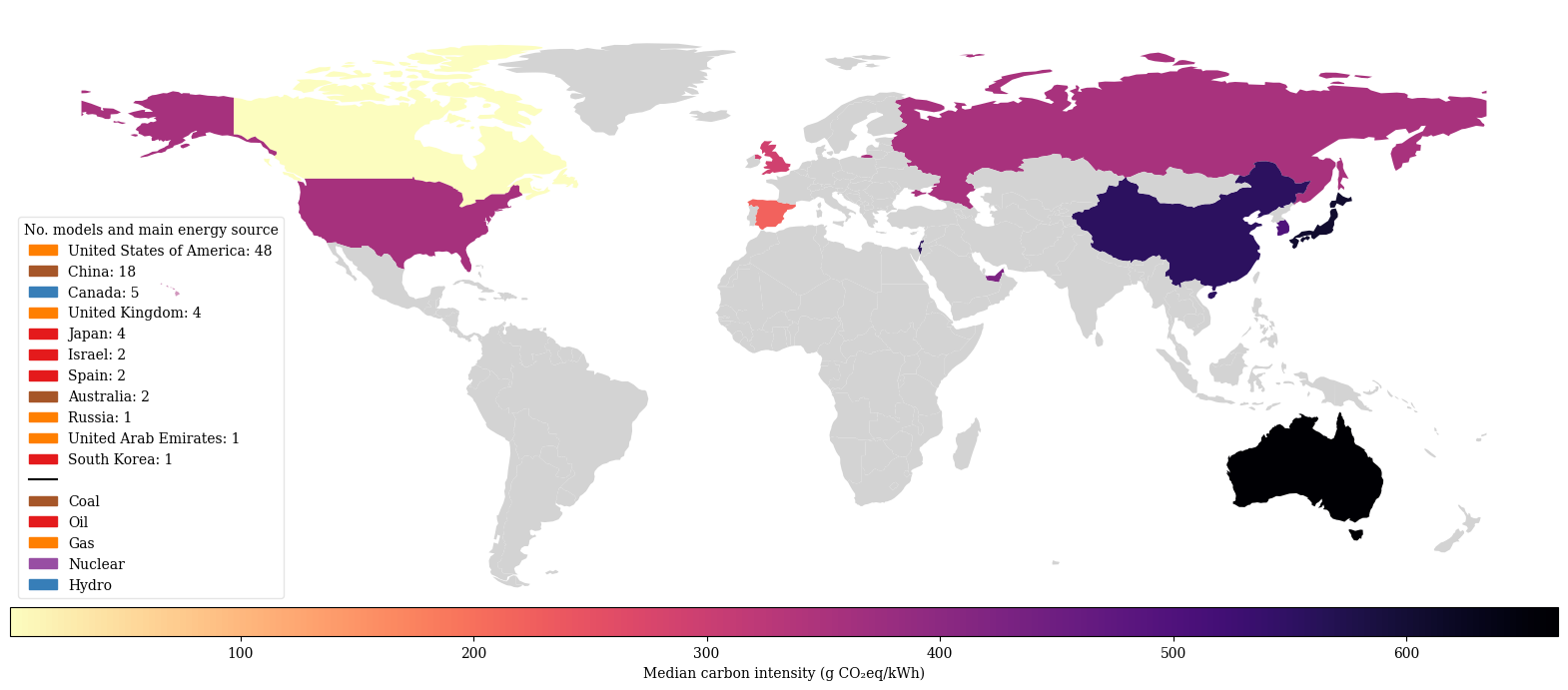] .references[ Luccioni and Hernandez-Garcia. [Counting Carbon: A Survey of Factors Influencing the Emissions of Machine Learning](https://arxiv.org/abs/2302.08476). arXiv 2302.08476, 2023. ] --- count: false ## Estimation of the ## carbon emissions of AI .context[The main factors are training time, electric power of hardware and carbon intensity.] In 2022, with Sasha Luccioni, we conducted an analysis of the carbon emissions of 95 machine learning models, asking the authors about the details of the training process. .center[] .conclusion[There exist large differences in the [carbon intensity of the energy grid](https://ourworldindata.org/grapher/carbon-intensity-electricity). From ~10 gCO2eq/kWh in the best case of hydroelectricity to nearly 700 gCO2eq/kWh for coal.] --- ## Estimation of the ## carbon emissions of AI ### Electric power .context[The main factors are training time, electric power of hardware and carbon intensity.] .center[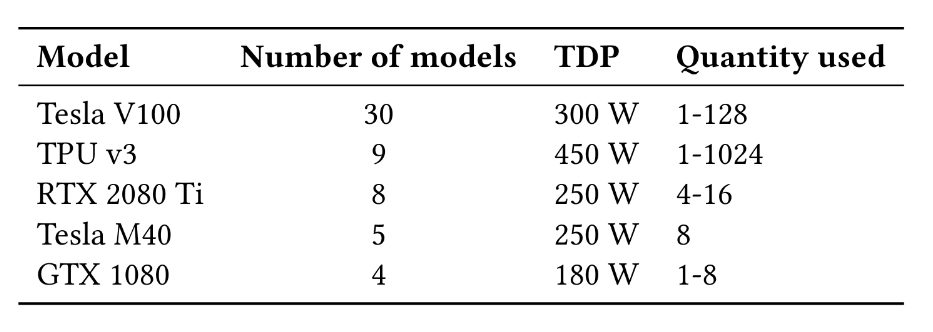] .conclusion[In contrast, there are no big differences in the choice of hardware (GPUs).] --- ## Estimation of the ## carbon emissions of AI .context[The main factors are training time, electric power of hardware and carbon intensity.] The carbon intensity depends on the energy grid and the electric power is similar for the various hardware options. .highlight1[The remaining factor is training time]. .center[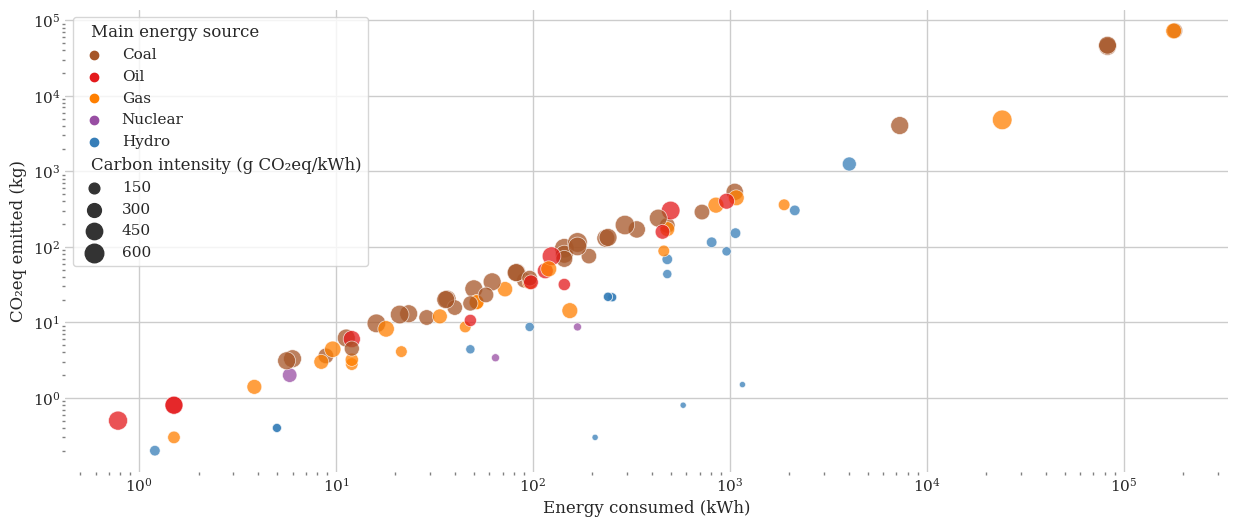] -- .conclusion[We found very large differences in training time across models and thus in the CO2eq emissions.] ??? Charging an average smartphone uses about 22 Wh. In terms of training time, the models in our sample range from just about 15 minutes (total GPU/TPU time) up to more than 400,000 hours, with a median of 72 hours, pointing again to large variance in our sample. While the maximum of 400,000 GPU hours (equivalent to about 170 days with 100 GPUs) in our sample seems very large, note that the total training time of GPT-3 was estimated to be over 3.5 million hours (14.8 days with 10,000 GPUs). The total carbon emissions of the models analyzed in our study is about 253 tons of CO2eq, which is equivalent to about 100 flights from London to San Francisco or from Nairobi to Beijing. --- ## Estimation of the carbon emissions of AI ### Comparison of models The .highlight1[lightest model] was trained in .highlight1[15 minutes], but .highlight2[one of the models needed 400,000 hours]. -- The .highlight1[total carbon emissions] of all models analysed in our sample (95) was about .highlight1[253 metric tons of CO2eq], which is equivalent to .highlight1[about 100 flights] from London to San Francisco. -- .highlight1[GPT-3], the "predecessor" of ChatGPT, needed .highlight1[3,5 million training hours] (14,8 days with 10,000 GPUs) and thus about .highlight1[500 tons of CO2eq], which corresponds to .highlight1[450 transatlantic flights]. --- ## Comparison of AI models .context35[Does more energy and CO2 lead to better model performance?] <br> .center[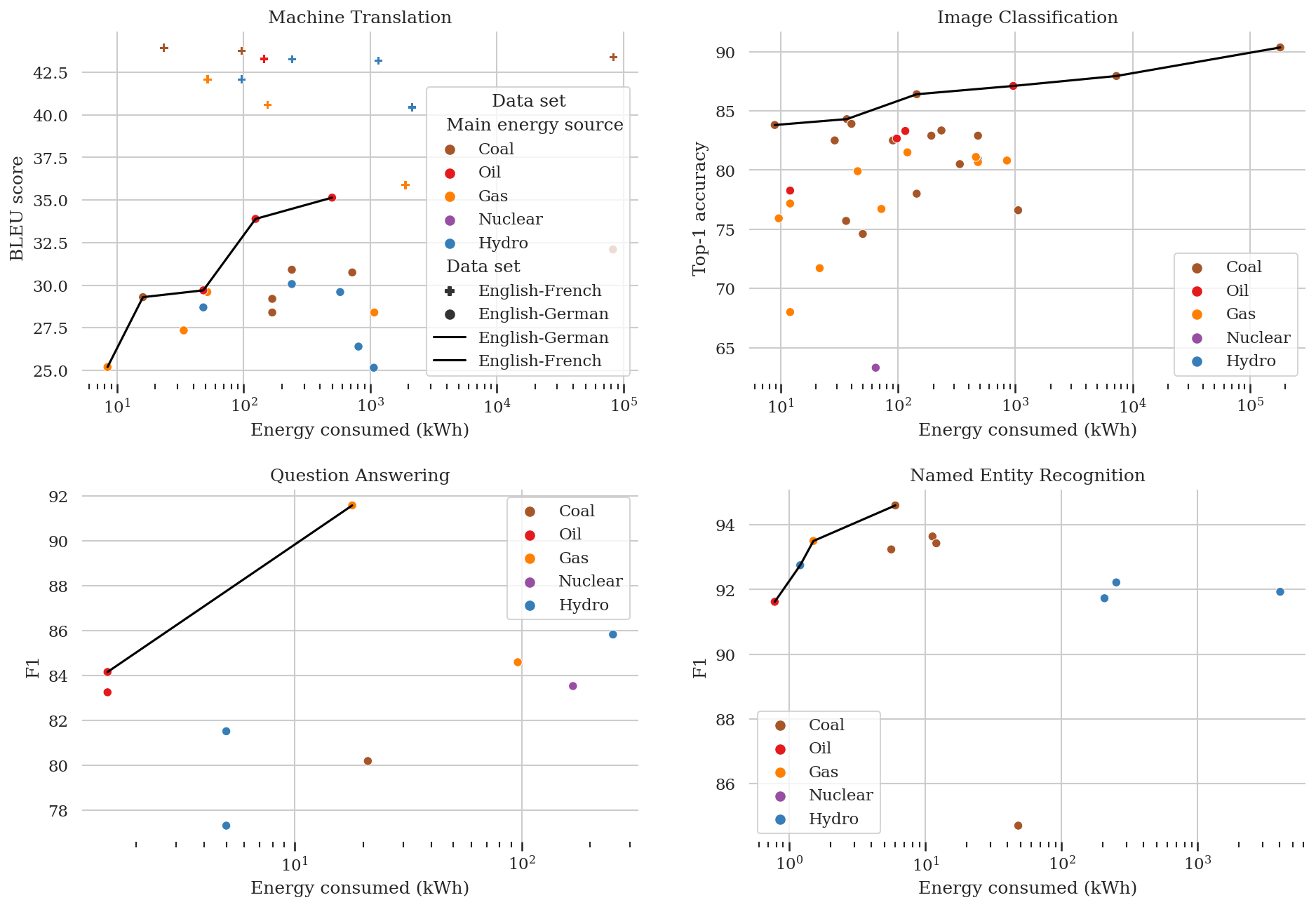] --- count: false ## Comparison of AI models .context35[Does more energy and CO2 lead to better model performance?] <br> .center[] .conclusion[One of the conclusions of our study is that there is little correlation between energy consumption and performance. _Bigger is not better_.] --- ## Comparison of AI models ### What can be said about modern large language models? First and foremost, big tech companies provide nearly no information about the energy used by their models. It is only thanks to the work of researchers that we know more and more: -- - The carbon emissions of training BLOOM were estimated in 25 tons of CO2eq. .cite[(Luccioni et al., 2022)] - At the peak of ChatGPT popularity in 2023, the tool consumed about 564 MWh of electricity per day, equivalent to the daily consumption of about 19,000 families in the United States. .cite[(de Vries, 2023)] .references[ - Luccioni, Viguier, Ligozat. [Estimating the Carbon Footprint of BLOOM, a 176B Parameter Language Model](https://arxiv.org/abs/2211.02001). arXiv 2211.02001, 2022. - de Vries. [The growing energy footprint of artificial intelligence](https://www.cell.com/action/showPdf?pii=S2542435123003653). CellPress, 2023. - Luccioni, Jernite, Strubell. [Power Hungry Processing: Watts Driving the Cost of AI Deployment?](https://arxiv.org/abs/2311.16863). arXiv 2311.16863, 2023. - [AI Energy Score](https://huggingface.co/spaces/AIEnergyScore/Leaderboard) ] ??? 25 tons of CO2eq are equivalent to 180,000 km en voiture. 25 tons of CO2eq are equivalent to 40 short-haul flights. https://www.openco2.net/en/co2-converter --- ## Comparison of AI models ### What can be said about modern large language models? .center[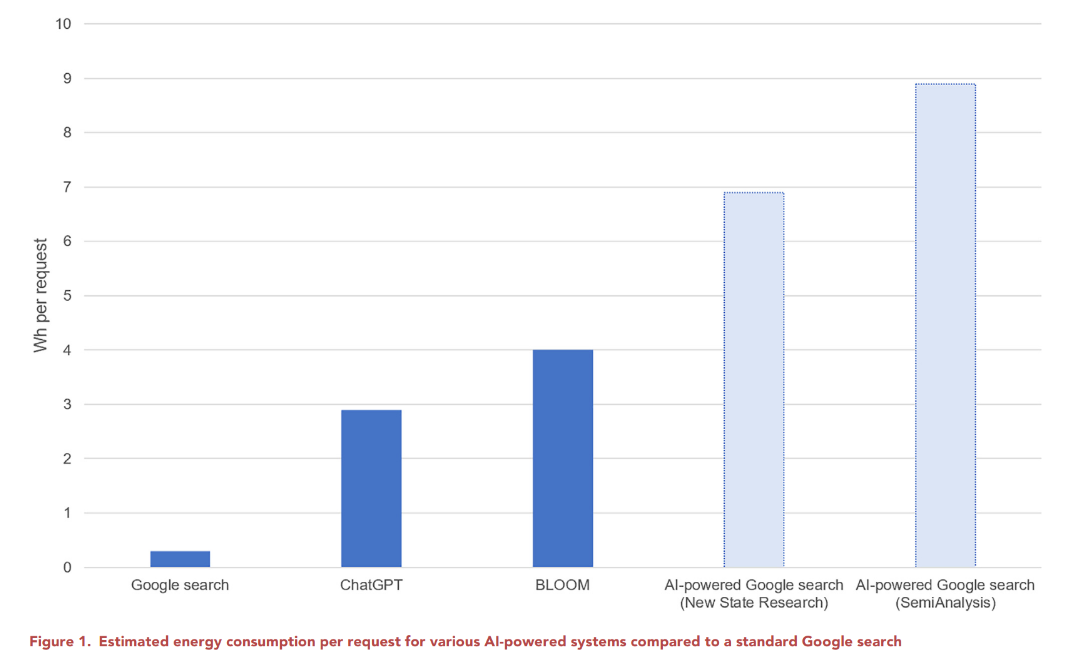] .references[ de Vries. [The growing energy footprint of artificial intelligence](https://www.cell.com/action/showPdf?pii=S2542435123003653). CellPress, 2023. ] --- count: false ## Comparison of AI models ### What can be said about modern large language models? .center[] .conclusion[One single interaction with ChatGPT could consume 10 times more energy than a Google search.] ??? Charging an average smartphone uses about 22 W. AI announces AI mode (May 20 2025): https://blog.google/products/search/google-search-ai-mode-update/#ai-mode-search --- ## Comparison of AI models ### What can be said about modern large language models? .center[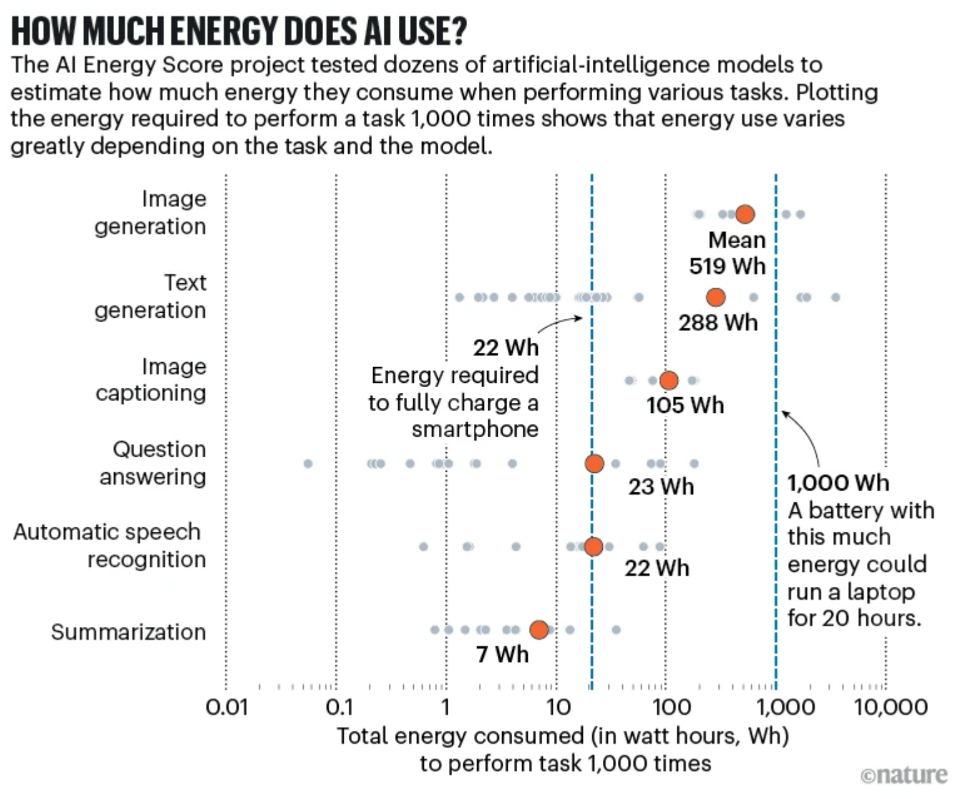] .references[ - [AI Energy Score](https://huggingface.co/spaces/AIEnergyScore/Leaderboard) - Chen. [How much energy will AI really consume? The good, the bad and the unknown](https://www.nature.com/articles/d41586-025-00616-z). Nature, News Feature, 2025. ] --- ## Energy demands of data centres ### Current estimates and future projections .center[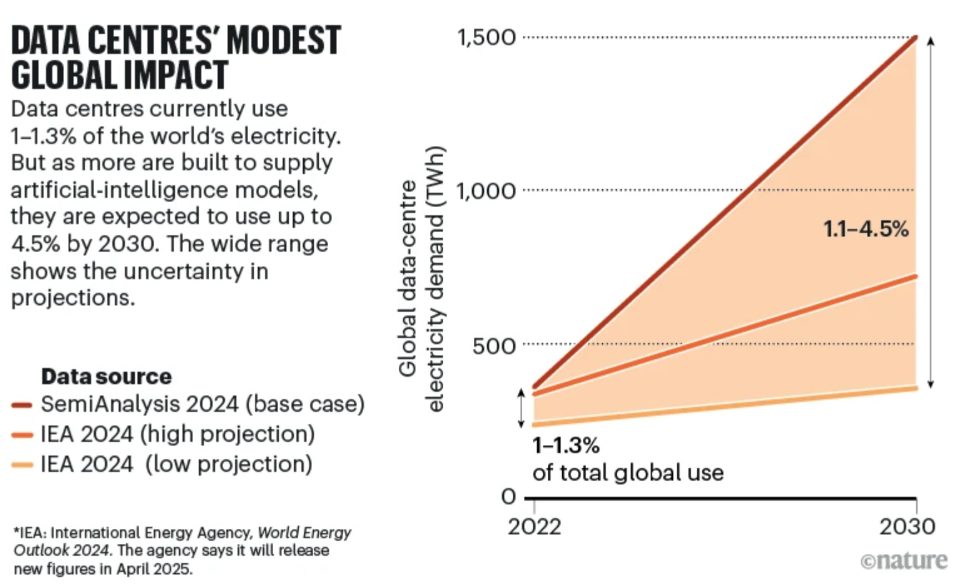] .references[ - Chen. [How much energy will AI really consume? The good, the bad and the unknown](https://www.nature.com/articles/d41586-025-00616-z). Nature, News Feature, 2025. ] --- ## Other direct impacts of AI .context[Large scale AI models are energy intensive and therefore emit GHGs.] <br> Besides energy, data centres and thus AI consume .highlight1[large quantities of drinking water] and require .highlight1[rare raw materials]. .center[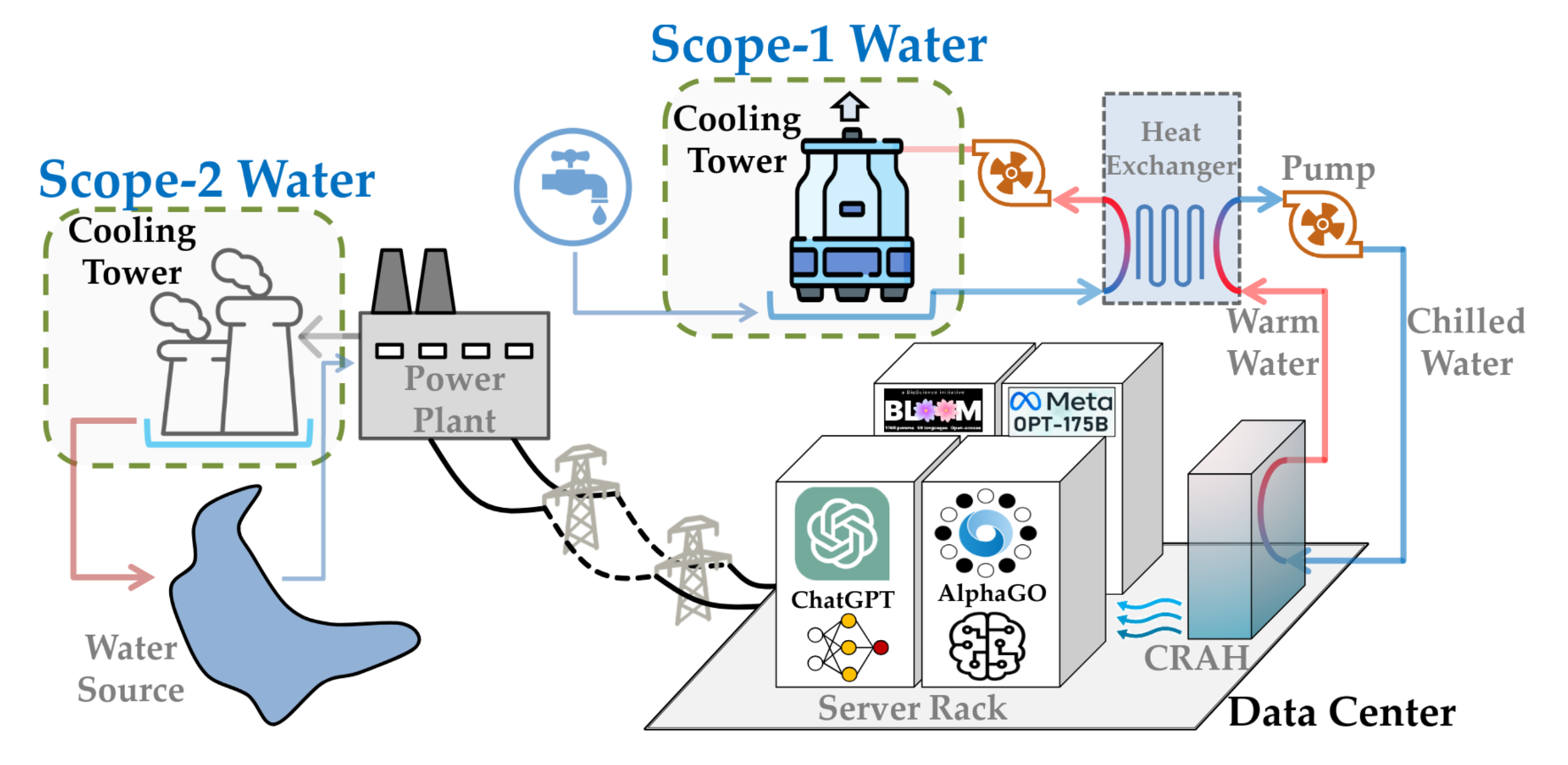] .references[ - Li et al. [Making AI Less "Thirsty": Uncovering and Addressing the Secret Water Footprint of AI Models](https://arxiv.org/abs/2304.03271). arXiv 2304.03271, 2023. - Crawford. [Atlas of AI](https://en.wikipedia.org/wiki/Atlas_of_AI), 2021 ] --- ## Other direct impacts of AI ### Water usage .left-column[ - According to Li et al., training GPT-3 evaporated 700,000 litres of clean freshwater in Microsoft's data centres. - "The global AI demand is projected to account for 4.2–6.6 billion cubic meters of water withdrawal in 2027, which is more than the total annual water withdrawal of half of the United Kingdom." ] .references[ - Li et al. [Making AI Less "Thirsty": Uncovering and Addressing the Secret Water Footprint of AI Models](https://arxiv.org/abs/2304.03271). arXiv 2304.03271, 2023. ] -- .right-column[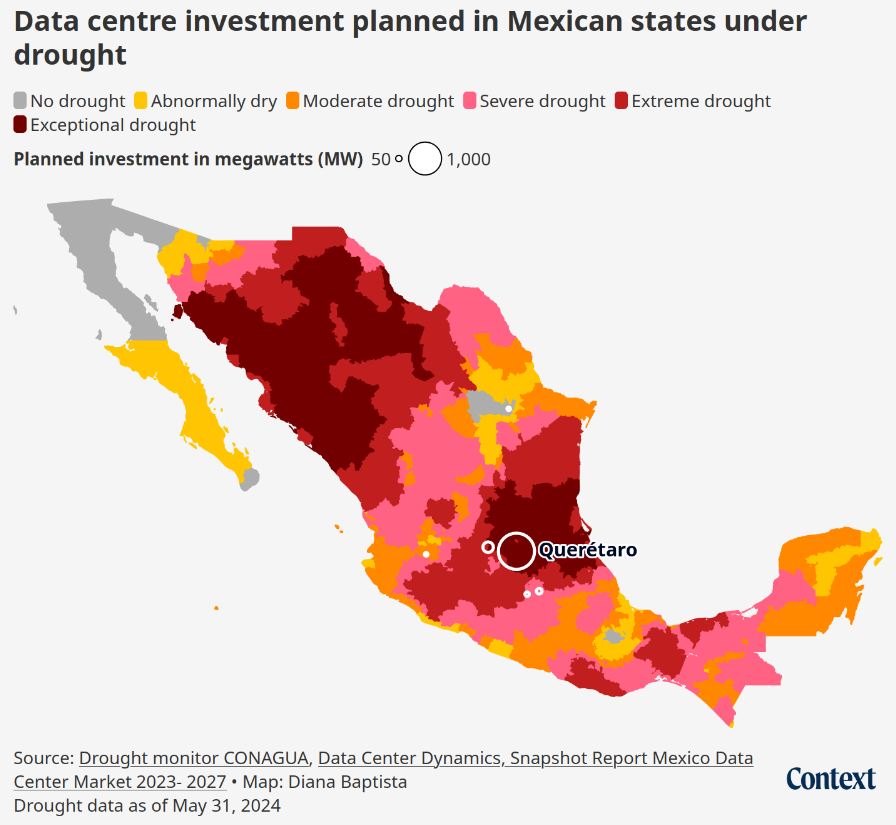] --- ## Initiatives to reduce the impact of AI 1. Increasing awareness about environmental impacts 2. Improving the transparency about resource utilisation 3. Using artificial intelligence tools in a moderate, proportional and conscious way. 4. Developing more efficient models 5. Promoting more efficient models -- Regarding efficiency, it is important to always remember [Jevons' paradox](https://www.sciencedirect.com/science/article/abs/pii/S0921800905001084?via%3Dihub): technological efficiency gains often increase overall resource use. .references[ - Alcott. [Jevons' paradox](https://www.sciencedirect.com/science/article/abs/pii/S0921800905001084?via%3Dihub), Ecological Economics, 2005. - Lange and Santarius. [Digitalization and energy consumption. Does ICT reduce energy demand?](https://doi.org/10.1016/j.ecolecon.2020.106760), Ecological Economics, 2020. ] ??? For example, historically, despite a one hundredfold efficiency increase from the first light bulb to a contemporary LED bulb, increase in electricity demand for light bulbs has entirely offset these gains. A landmark study concluded that “global energy use for lighting has experienced 100% rebound over 300 years, six continents, and five technologies” (Saunders and Tsao 2012; Tsao et al. 2010). (Insolvent) 100x efficiency gains since first bulb but 2x more energy usage --- ## On the conscious use of AI .context35[Recently, AI has been deployed in a large number of our daily tools.] <br> Copilot is an example of integration of AI in professional development tools. Researchers in France have studied the energy impact. .center[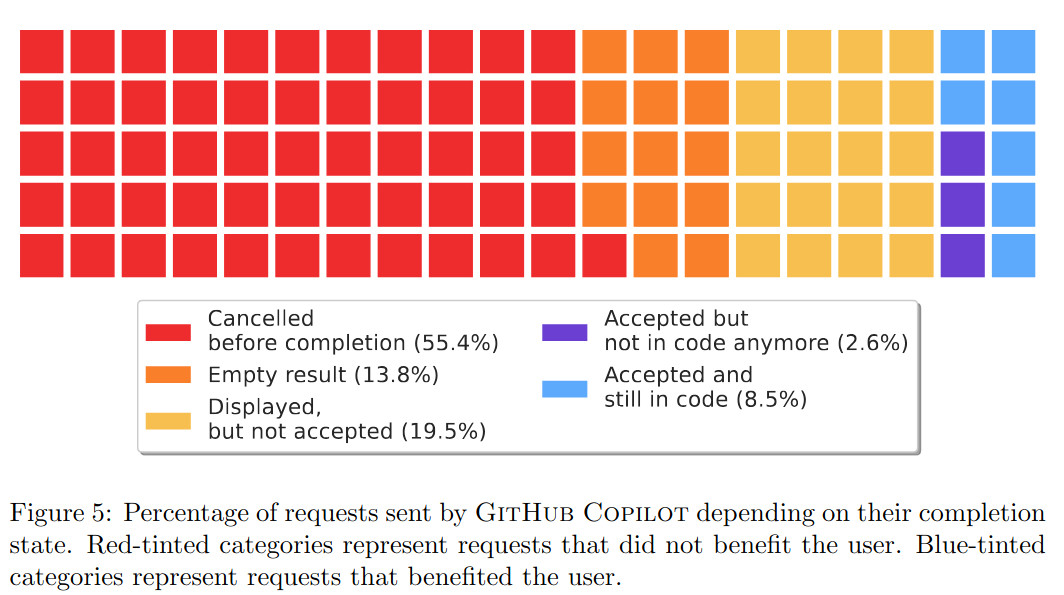] .references[ Coignion, Quinton, Rouvoy. [Green My LLM: Studying the key factors affecting the energy consumption of code assistants](https://arxiv.org/abs/2411.11892), arXiv 2411.11892, 2024. ] --- count: false ## On the conscious use of AI .context35[Recently, AI has been deployed in a large number of our daily tools.] <br> Copilot is an example of integration of AI in professional development tools. Researchers in France have studied the energy impact. .center[] .conclusion[Most Copilot results are simply wasted.] --- ## Beyond environmental impact -- There is a large body of research studying the negative social impacts of AI: - Centralisation of power and increase of inequality - Exploitative working conditions - Discrimination of racialised people - Propagation of discriminatory biases - Spread of mis/disinformation - Infringement of creators rights .references[ - Crawford. [Atlas of AI](https://en.wikipedia.org/wiki/Atlas_of_AI), 2021 - DW. [How big AI companies exploit data workers in Kenya](https://www.youtube.com/watch?v=ehkECk2KJjY), 2024 - Kalluri. [Don’t ask if artificial intelligence is good or fair, ask how it shifts power](https://www.nature.com/articles/d41586-020-02003-2), Nature, 2020 - Bender, Gebru, McMillan-Major, Shmitchell. [On the Dangers of Stochastic Parrots: Can Language Models Be Too Big? 🦜](https://dl.acm.org/doi/10.1145/3442188.3445922), FAccT, 2021 - Mohamed, Png, Isaac. [Decolonial AI: Decolonial Theory as Sociotechnical Foresight in Artificial Intelligence](https://arxiv.org/abs/2007.04068), Philosophy and Technology, 2020. - Benjamin. [Race After Technology: Abolitionist Tools for the New Jim Code](https://en.wikipedia.org/wiki/Race_After_Technology), Polity, 2019. - West, Whittaker, Crawford. [Discriminating Systems: Gender, Race, and Power in AI – Report](https://ainowinstitute.org/publications/discriminating-systems-gender-race-and-power-in-ai-2), AI Now, 2019. ] ??? - Mention Microsoft's deals with fossil fuel companies - Major tech companies like Microsoft and Google just reported rises in resource uses previously unheard of, stopped carbon offsetting, and announced that they would miss their already loose (Hoffmann, 2022) sustainability pledges, precisely because of their large scale AI roll-out (e.g. Marx, 2024; Metz, 2024; Rathi & Bass, 2024). --- ## Beyond environmental impact .left-column[ <figure> <img src="../assets/images/slides/ai-military/lavender.png" alt="‘Lavender’: The AI machine directing Israel’s bombing spree in Gaza" style="width: 110%"> <figcaption>.center[.smaller[<a href="https://www.972mag.com/lavender-ai-israeli-army-gaza/">+972 Magazine</a>, April 3rd 2024]]</figcaption> </figure> <figure> <img src="../assets/images/slides/ai-military/habsora.png" alt="‘A mass assassination factory’: Inside Israel’s calculated bombing of Gaza" style="width: 110%"> <figcaption>.center[.smaller[<a href="https://www.972mag.com/mass-assassination-factory-israel-calculated-bombing-gaza/">+972 Magazine</a>, November 30th 2023]]</figcaption> </figure> <figure> <img src="../assets/images/slides/ai-military/google_lockheed_martin.png" alt="Lockheed Martin and Google Cloud Collaborate to Advance Generative AI for National Security" style="width: 110%"> <figcaption>.center[.smaller[<a href="https://www.lockheedmartin.com/en-us/news/features/2025/lockheed-martin-google-collaborate-to-advance-generative-ai-national-security.html">Lockheed Martin</a>, March 27th 2025]]</figcaption> </figure> ] .right-column[ <figure> <img src="../assets/images/slides/ai-military/nimbus_wired.png" alt="The Hidden Ties Between Google and Amazon’s Project Nimbus and Israel's Military" style="width: 110%"> <figcaption>.center[.smaller[<a href="https://www.wired.com/story/amazon-google-project-nimbus-israel-idf/">WIRED</a>, July 15th 2024]]</figcaption> </figure> <figure> <img src="../assets/images/slides/ai-military/microsoft_dalle_us_army.png" alt="Microsft pitched OpenAI's DALL-E as battlefield tool for U.S. military" style="width: 110%"> <figcaption>.center[.smaller[<a href="https://theintercept.com/2024/04/10/microsoft-openai-dalle-ai-military-use/">The Intercept</a>, April 10th 2024]]</figcaption> </figure> ] --- count: false name: title class: title, middle ## Our role in the responsible use and development of AI .center[] --- ## Our role in the responsible use and development of AI ### A personal reflection As machine learning scientist, I am in a position to conceive and contribute to: - artificial intelligence algorithms - systems and infrastructures that use artificial intelligence -- .center[.bigger[.highlight1[Am I / are we responsible for the harms to humans and the environment caused by artificial intelligence systems?]]] -- This poses other questions: - What does it mean to be responsible? - How can we measure and attribute responsibility? - What positions are available to each of us when we become aware of our roles? --- ## _The implicated subject_ .left-column-66[The book _The Implicated Subject_ by Michael Rothberg develops a framework and vocabulary for analysing the complexity of responsibility.] .right-column-33[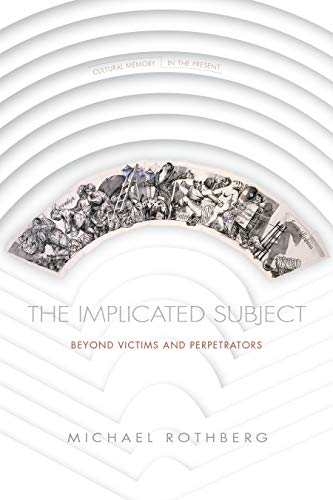] -- .left-column-66[ > .highlight1[_An implicated subject is neither a victim nor a perpetrator], but rather a participant in histories and social formations that generate the positions of victim and perpetrator, and yet in which most people do not occupy such clear-cut roles. Less “actively” involved than perpetrators, implicated subjects do not fit the mold of the “passive” bystander, either._ ] -- .left-column-66[ > _Although indirect or belated, [implicated subjects'] .highlight1[actions and inactions help produce and reproduce the positions of victims and perpetrators]._ ] --- ## Scientists as implicated subjects ### What can we do? In my opinion, considering myself as an implicated subjec is helpful for developing action plans and allowing myself to .highlight1[adjust my level of involvement]. -- My personal attitude: 1. Understand in more depth not only the direct but also indirect impacts of my work. -- 2. Develop strategies to mitigate my own impact. -- 3. Consider refusal as a valid attitude. -- 4. Develop strategies to mitigate systemic impact. -- .conclusion[Implication means responibility but also the possibility of changing the situation.] --- ## To know more .columns-4[.center[ <figure> <img src="../assets/images/slides/responsibility-ai/the_implicated_subject_cover.jpg" alt="The Implicated Subject, Michael Rothberg (2019)" style="width: 95%"> <figcaption>.smaller[[The Implicated Subject, Michael Rothberg (2019)](https://www.sup.org/books/literary-studies-and-literature/implicated-subject)]</figcaption> </figure> ]] .columns-4[.center[ <figure> <img src="../assets/images/slides/science-as-critical-thinking/science_as_social_knowledge.gif" alt="Science as Social Knowledge, Helen Longino (1990)" style="width: 95%"> <figcaption>.smaller[[Science as Social Knowledge, Helen Longino (1990)](https://www.jstor.org/stable/j.ctvx5wbfz)]</figcaption> </figure> ]] .columns-4[.center[ <figure> <img src="../assets/images/slides/science-as-critical-thinking/atlas_of_ai.jpg" alt="Atlas of AI, Kate Crawford (2021)" style="width: 95%"> <figcaption>.smaller[[Atlas of AI, Kate Crawford (2021)](https://en.wikipedia.org/wiki/Atlas_of_AI)]</figcaption> </figure> ]] .columns-4[.center[ <figure> <img src="../assets/images/slides/ai-env-impact/insolvent.jpg" alt="Insolvent, Christoph Becker (2023)" style="width: 95%"> <figcaption>.smaller[[Insolvent, Christoph Becker (2023)](https://direct.mit.edu/books/oa-monograph/5594/InsolventHow-to-Reorient-Computing-for-Just)]</figcaption> </figure> ]] --- count: false name: title class: title, middle ## The role of AI in sustainability .center[] --- ## Overview of applications of artificial intelligence to tackle the climate crisis .highlight1[Artificial intelligence] should not be seen as the solution to the climate crisis and we have seen how it can make it worse. However, some people do believe that it .highlight1[may be used in multiple applications] connected to.highlight1[mitigation] of climate change and .highglight1[adaptation] to it. - Energy optimisation of buildings and infrastructures. - Optimisation of production and distribution of energy - Prediction and management of natural resources - Optimisation and management of transport networks - Improvement of climate models - Raising awareness about climate change - Design of new materials for sustainability .references[ - Rolnick et al. [Tackling Climate Change with Machine Learning](https://dl.acm.org/doi/10.1145/3485128), ACM Computing Surveys, 2022. - van Wynsberghe. [Sustainable AI: AI for sustainability and the sustainability of AI](https://link.springer.com/article/10.1007/s43681-021-00043-6), AI and Ethics, 2021. ] ??? Optimisation according to what? --- ## Can AI be _truly_ for good? -- > _Any AI technology in the sustainability struggle will, if continuing on the current path, very likely do more harm than good and might even be a distraction from the actually relevant societal tasks of a sustainability transformation._ .cite[(Rehak, 2024)] -- > _Sustainable AI is the technical solution to the climate crisis from a techno-solutionist vantage point simply reproducing the status quo. The enthusiasm for sustainable AI primarily serves hegemonic interests, rather than genuinely aiming for resource-friendly and ethical solutions._ .cite[(Schütze, 2024)] -- .references[ - Rehak. [On the (im)possibility of sustainable artificial intelligence](https://policyreview.info/articles/news/impossibility-sustainable-artificial-intelligence/1804), Internet Policy Review, 2024. - Schütze. [The Problem of Sustainable AI: A Critical Assessment of an Emerging Phenomenon](https://ojs.weizenbaum-institut.de/index.php/wjds/article/view/4_1_4/119), Weizenbaum Journal, 2024. ] --- ## Summary and discussion - Artificial intelligence can be very energy intensive due to the large-scale and widespread deployment. - But small-scale machine learning models do exist. - AI is responsible for other severe environmental impacts such as water withdrawal and materials usage. - There is also a wide range of ethical and social impacts of AI, including the increasing use of AI in warfare. - A holistic and radical perspective allows us to see the entanglement of all these impacts. - Machine learning may play a role in the mitigation of and adaption to the climate crisis, but it is important to critically examine this role. <br> -- - Could AI be sustainable? Under what conditions? - Small AI instead of scaling and general purpose _AGI_? Digital degrowth? - What is the role of AI in sustainability? - What is our implication on the AI impacts as users, developers, scientists, policy-makers...? --- name: mila-ethics-sustainability-may25 class: title, middle Alex Hernández-García (he/il/él) .center[ <a href="https://mila.quebec/"><img src="../assets/images/slides/logos/mila-beige.png" alt="Mila" style="height: 3em"></a> <a href="https://www.umontreal.ca/"><img src="../assets/images/slides/logos/udem-white.png" alt="UdeM" style="height: 3em"></a> <a href="https://institut-courtois.umontreal.ca/"><img src="../assets/images/slides/logos/institut-courtois.png" alt="Institut Courtois" style="height: 3em"></a> <a href="https://ivado.ca/"><img src="../assets/images/slides/logos/ivado.png" alt="IVADO" style="height: 3em"></a> ] .center[ <a href="http://www.scienceforthepeople.ca/"><img src="../assets/images/slides/science-as-critical-thinking/sftp.png" alt="Science for the People" style="height: 4em"></a> ] .footer[[alexhernandezgarcia.github.io](https://alexhernandezgarcia.github.io/) | [alex.hernandez-garcia@mila.quebec](mailto:alex.hernandez-garcia@mila.quebec)] | [alexhergar.bsky.social](https://bsky.app/profile/alexhergar.bsky.social) [](https://bsky.app/profile/alexhergar.bsky.social)<br> .smaller[.footer[ Slides: [alexhernandezgarcia.github.io/slides/{{ name }}](https://alexhernandezgarcia.github.io/slides/{{ name }}) ]]